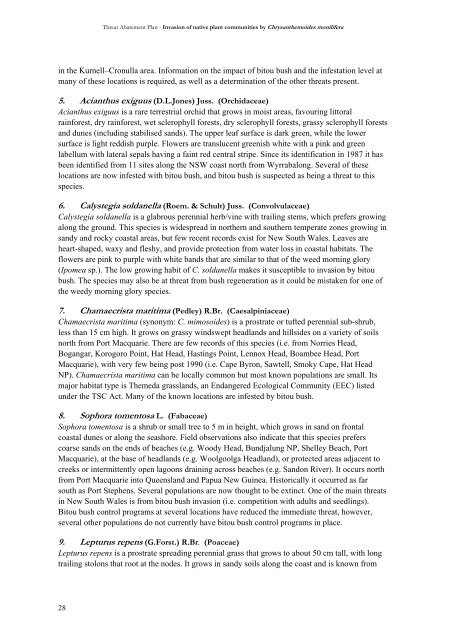NSW Bitou Bush Threat Abatement Plan - Department of ...
NSW Bitou Bush Threat Abatement Plan - Department of ...
NSW Bitou Bush Threat Abatement Plan - Department of ...
You also want an ePaper? Increase the reach of your titles
YUMPU automatically turns print PDFs into web optimized ePapers that Google loves.
28<br />
<strong>Threat</strong> <strong>Abatement</strong> <strong>Plan</strong> - Invasion <strong>of</strong> native plant communities by Chrysanthemoides monilifera<br />
in the Kurnell–Cronulla area. Information on the impact <strong>of</strong> bitou bush and the infestation level at<br />
many <strong>of</strong> these locations is required, as well as a determination <strong>of</strong> the other threats present.<br />
5. Acianthus exiguus (D.L.Jones) Juss. (Orchidaceae)<br />
Acianthus exiguus is a rare terrestrial orchid that grows in moist areas, favouring littoral<br />
rainforest, dry rainforest, wet sclerophyll forests, dry sclerophyll forests, grassy sclerophyll forests<br />
and dunes (including stabilised sands). The upper leaf surface is dark green, while the lower<br />
surface is light reddish purple. Flowers are translucent greenish white with a pink and green<br />
labellum with lateral sepals having a faint red central stripe. Since its identification in 1987 it has<br />
been identified from 11 sites along the <strong>NSW</strong> coast north from Wyrrabalong. Several <strong>of</strong> these<br />
locations are now infested with bitou bush, and bitou bush is suspected as being a threat to this<br />
species.<br />
6. Calystegia soldanella (Roem. & Schult) Juss. (Convolvulaceae)<br />
Calystegia soldanella is a glabrous perennial herb/vine with trailing stems, which prefers growing<br />
along the ground. This species is widespread in northern and southern temperate zones growing in<br />
sandy and rocky coastal areas, but few recent records exist for New South Wales. Leaves are<br />
heart-shaped, waxy and fleshy, and provide protection from water loss in coastal habitats. The<br />
flowers are pink to purple with white bands that are similar to that <strong>of</strong> the weed morning glory<br />
(Ipomea sp.). The low growing habit <strong>of</strong> C. soldanella makes it susceptible to invasion by bitou<br />
bush. The species may also be at threat from bush regeneration as it could be mistaken for one <strong>of</strong><br />
the weedy morning glory species.<br />
7. Chamaecrista maritima (Pedley) R.Br. (Caesalpiniaceae)<br />
Chamaecrista maritima (synonym: C. mimosoides) is a prostrate or tufted perennial sub-shrub,<br />
less than 15 cm high. It grows on grassy windswept headlands and hillsides on a variety <strong>of</strong> soils<br />
north from Port Macquarie. There are few records <strong>of</strong> this species (i.e. from Norries Head,<br />
Bogangar, Korogoro Point, Hat Head, Hastings Point, Lennox Head, Boambee Head, Port<br />
Macquarie), with very few being post 1990 (i.e. Cape Byron, Sawtell, Smoky Cape, Hat Head<br />
NP). Chamaecrista maritima can be locally common but most known populations are small. Its<br />
major habitat type is Themeda grasslands, an Endangered Ecological Community (EEC) listed<br />
under the TSC Act. Many <strong>of</strong> the known locations are infested by bitou bush.<br />
8. Sophora tomentosa L. (Fabaceae)<br />
Sophora tomentosa is a shrub or small tree to 5 m in height, which grows in sand on frontal<br />
coastal dunes or along the seashore. Field observations also indicate that this species prefers<br />
coarse sands on the ends <strong>of</strong> beaches (e.g. Woody Head, Bundjalung NP, Shelley Beach, Port<br />
Macquarie), at the base <strong>of</strong> headlands (e.g. Woolgoolga Headland), or protected areas adjacent to<br />
creeks or intermittently open lagoons draining across beaches (e.g. Sandon River). It occurs north<br />
from Port Macquarie into Queensland and Papua New Guinea. Historically it occurred as far<br />
south as Port Stephens. Several populations are now thought to be extinct. One <strong>of</strong> the main threats<br />
in New South Wales is from bitou bush invasion (i.e. competition with adults and seedlings).<br />
<strong>Bitou</strong> bush control programs at several locations have reduced the immediate threat, however,<br />
several other populations do not currently have bitou bush control programs in place.<br />
9. Lepturus repens (G.Forst.) R.Br. (Poaceae)<br />
Lepturus repens is a prostrate spreading perennial grass that grows to about 50 cm tall, with long<br />
trailing stolons that root at the nodes. It grows in sandy soils along the coast and is known from
















